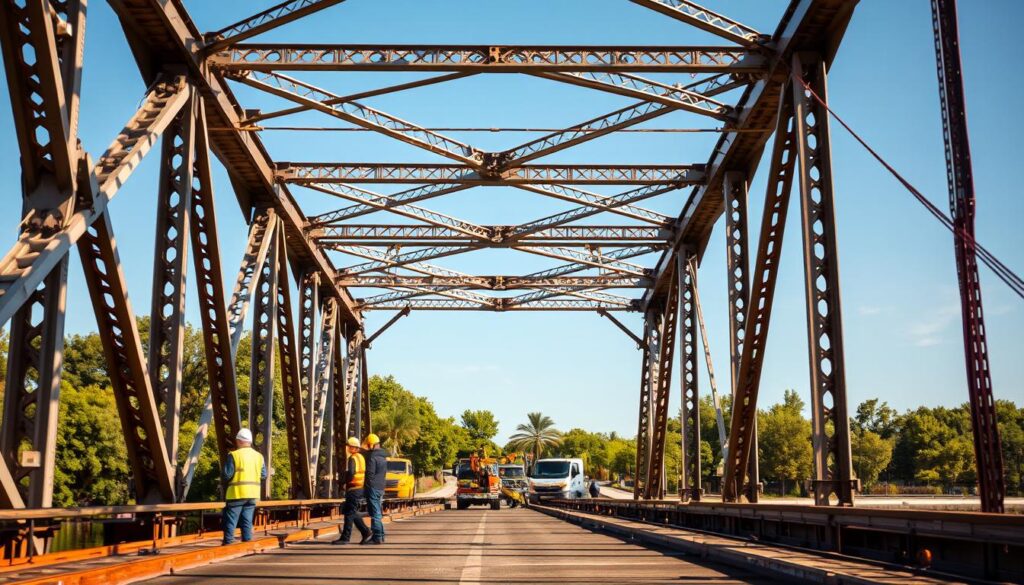Can a single failure in infrastructure maintenance solutions lead to catastrophic consequences? The importance of bridge maintenance engineering cannot be overstated, as it plays a critical role in ensuring the safety and longevity of our nation’s bridges.
At BNSF, maintaining safe and reliable infrastructure is paramount. Their rigorous Bridge Management Program includes comprehensive inspections, regular maintenance, and replacement of rail bridges as necessary, underscoring the significance of proactive infrastructure maintenance solutions.
Key Takeaways
- Regular inspections are crucial for identifying potential issues before they become major problems.
- A comprehensive Bridge Management Program is essential for ensuring safe crossings.
- Proactive maintenance is key to preventing accidents and ensuring the longevity of bridges.
- Infrastructure maintenance solutions play a vital role in maintaining safe and reliable infrastructure.
- Effective bridge maintenance engineering requires a combination of inspections, maintenance, and replacement as needed.
Understanding Bridge Maintenance Engineering
The safety and reliability of bridges depend heavily on effective bridge maintenance engineering practices. This discipline is crucial for ensuring the longevity and structural integrity of bridges, which are vital components of a country’s infrastructure.
Definition and Importance
Bridge maintenance engineering involves the application of engineering principles to maintain, repair, and inspect bridges. It encompasses a range of activities, including bridge inspection methods, to identify potential issues before they become major problems. The importance of bridge maintenance engineering lies in its ability to prevent accidents, reduce the need for costly repairs, and ensure the continued functionality of bridges.
Effective bridge maintenance is not just about fixing problems; it’s also about preventing them. By employing advanced bridge maintenance techniques, engineers can extend the lifespan of bridges, improve safety, and minimize disruptions to traffic.
Key Principles of Bridge Maintenance
The key principles of bridge maintenance engineering include regular inspections, timely repairs, and the use of appropriate materials and techniques. Bridge inspection methods are critical for identifying signs of deterioration or damage, allowing for early intervention. Maintenance planning is also essential, as it ensures that resources are allocated efficiently and that maintenance activities are carried out with minimal disruption to users.
By understanding and applying these principles, bridge maintenance engineers can ensure that bridges remain safe and functional, supporting the overall infrastructure and contributing to the well-being of communities.
Types of Bridge Maintenance
Bridge maintenance is categorized into several types, each serving a distinct purpose in preserving bridge functionality. Effective bridge maintenance is crucial for ensuring the longevity and safety of crossings. The primary types of bridge maintenance include preventive maintenance, corrective maintenance, and routine inspections.
Preventive Maintenance
Preventive maintenance involves proactive measures to prevent or delay the deterioration of bridge components. This type of maintenance is essential for reducing the need for costly repairs down the line. Examples of preventive maintenance include applying protective coatings to steel components, sealing concrete to prevent water intrusion, and performing regular cleaning to remove debris.
Best practices in preventive maintenance include regular inspections to identify potential issues before they become major problems. By addressing these issues early, maintenance teams can prevent minor problems from escalating into significant repairs.
Corrective Maintenance
Corrective maintenance is performed to repair or replace damaged or deteriorated bridge components. This type of maintenance is reactive, meaning it is carried out in response to identified issues. Corrective maintenance can range from minor repairs, such as fixing cracks in the bridge deck, to major rehabilitation projects, such as replacing entire structural elements.
Bridge rehabilitation strategies often involve a combination of corrective and preventive maintenance. For instance, when a bridge is found to have significant structural damage, a rehabilitation project might include not only repairing the damaged areas but also applying preventive measures to protect the rest of the structure.
Routine Inspections
Routine inspections are a critical component of bridge maintenance. These inspections involve a thorough examination of the bridge structure to identify any signs of deterioration or damage. Regular comprehensive inspections encompass the entire bridge structure and meet or exceed the federally required frequency.
“Regular inspections are the backbone of effective bridge maintenance. By identifying issues early, we can prevent minor problems from becoming major repairs.” –
Specialized training is required for all bridge inspectors to ensure they can accurately identify potential issues. The data collected during these inspections informs maintenance planning and helps prioritize repairs.
| Type of Maintenance | Description | Examples |
|---|---|---|
| Preventive Maintenance | Proactive measures to prevent deterioration | Applying protective coatings, sealing concrete |
| Corrective Maintenance | Repair or replacement of damaged components | Fixing cracks, replacing structural elements |
| Routine Inspections | Thorough examination to identify deterioration or damage | Visual inspections, use of inspection technologies |

The Bridge Maintenance Process
To keep bridges safe and functional, maintenance engineers follow a structured process that includes regular inspections and maintenance planning. This process is critical for identifying potential issues before they become major problems, thereby ensuring the longevity of the bridge.
Assessment and Evaluation Methods
Assessment and evaluation are key components of the bridge maintenance process. Engineers use various methods to assess the condition of a bridge, including visual inspections, non-destructive testing, and load testing. These methods help identify signs of deterioration or damage, such as cracks, corrosion, or structural deformation.
Common assessment techniques include:
- Visual inspections to identify visible signs of damage or deterioration.
- Non-destructive testing methods, such as ultrasonic testing or ground-penetrating radar, to detect internal flaws.
- Load testing to evaluate the bridge’s capacity to withstand various loads.
The Federal Railroad Administration (FRA) requires railroads to have a Bridge Management Program, which includes regular inspections and assessments to ensure the safety of railroad bridges. This regulatory requirement underscores the importance of thorough assessment and evaluation in bridge maintenance.
Maintenance Planning Strategies
Effective maintenance planning is crucial for ensuring that bridge maintenance activities are carried out efficiently and effectively. This involves developing a comprehensive maintenance plan that takes into account the results of assessments and evaluations, as well as factors such as traffic volume, environmental conditions, and budget constraints.
A well-structured maintenance plan should include:
| Strategy | Description | Benefits |
|---|---|---|
| Preventive Maintenance | Regular activities to prevent deterioration. | Reduces the likelihood of major repairs. |
| Corrective Maintenance | Repairs to address identified issues. | Restores the bridge’s structural integrity. |
| Predictive Maintenance | Using data and analytics to predict when maintenance is needed. | Optimizes maintenance scheduling and reduces costs. |
By implementing these strategies, bridge management systems can ensure that maintenance activities are carried out in a timely and cost-effective manner, ultimately contributing to the safety and longevity of the bridge.
Tools and Technologies in Bridge Maintenance
The use of advanced tools and technologies has become crucial in maintaining the safety and durability of bridges. With the integration of innovative inspection methods and maintenance techniques, bridge maintenance engineering has seen significant improvements.
Advanced Inspection Technologies
Advanced inspection technologies play a vital role in assessing the condition of bridges. For instance, BNSF utilizes Bridge Inspection Vehicles (BIVs) that are specially equipped to allow safe access to inspect the entire bridge structure. These vehicles enable inspectors to reach all parts of the bridge, ensuring a thorough assessment.
Sonar scanning technology is another advanced method used, particularly for inspecting underwater bridge foundations. This technology provides detailed images of the foundation’s condition, helping engineers identify potential issues early.
Use of Drones in Bridge Inspections
Drones have emerged as a valuable tool in bridge inspections, offering a safe and efficient way to assess bridge conditions. Equipped with high-resolution cameras and sensors, drones can capture detailed images and data, reducing the need for manual inspections in hard-to-reach areas.
The use of drones not only enhances safety but also reduces inspection time and costs. By leveraging drone technology, maintenance teams can quickly identify areas that require repair or further inspection.
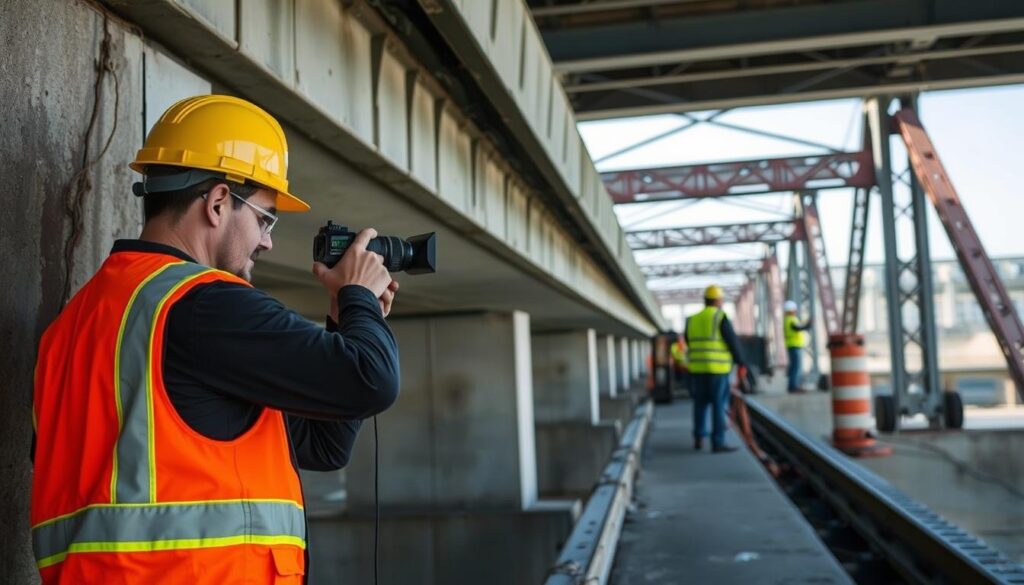
Software for Maintenance Management
Effective maintenance management is crucial for the longevity of bridges. Specialized software helps in planning, tracking, and managing maintenance activities. These software solutions enable maintenance teams to schedule inspections, record findings, and prioritize repairs based on the severity of the issues identified.
By utilizing maintenance management software, bridge owners can ensure that maintenance activities are carried out efficiently and effectively, ultimately extending the lifespan of the bridge.
| Technology | Description | Benefits |
|---|---|---|
| Bridge Inspection Vehicles (BIVs) | Specially equipped vehicles for safe access to all parts of the bridge. | Enhanced safety, thorough inspections. |
| Sonar Scanning Technology | Used for inspecting underwater bridge foundations. | Detailed imaging, early issue detection. |
| Drones | Equipped with cameras and sensors for assessing bridge conditions. | Improved safety, reduced inspection time and costs. |
| Maintenance Management Software | Helps in planning, tracking, and managing maintenance activities. | Efficient maintenance scheduling, prioritized repairs. |
Challenges in Bridge Maintenance Engineering
The field of bridge maintenance engineering is fraught with challenges, from structural concerns to budgetary constraints. Ensuring the longevity and safety of bridges requires addressing these challenges effectively.
Structural Integrity Concerns
One of the primary challenges in bridge maintenance is maintaining the structural integrity of the bridge. This involves regular inspections and timely repairs to prevent deterioration. As noted by experts, “In the rare instance a structural defect is identified, engineering guidelines ensure appropriate protection is established, up to and including removing the bridge from rail service, until the defect is repaired.” This proactive approach is crucial in preventing accidents and ensuring the safety of users.
Effective bridge rehabilitation strategies are essential for maintaining structural integrity. These strategies often involve a combination of preventive and corrective maintenance techniques.
Funding and Budget Restrictions
Another significant challenge is the constraint imposed by limited funding and budget restrictions. Bridge maintenance requires substantial investment, and securing adequate funding can be difficult. According to a report on geotechnical engineering and bridge maintenance, innovative funding solutions and prioritization of maintenance projects are critical.
| Challenge | Description | Potential Solution |
|---|---|---|
| Structural Integrity | Maintaining the bridge’s structural soundness | Regular inspections and timely repairs |
| Funding Constraints | Limited budget for maintenance activities | Innovative funding solutions and project prioritization |
Implementing infrastructure maintenance solutions that are cost-effective and efficient is vital. This can involve leveraging technology, such as drones for inspections, and adopting sustainable practices.
“The key to successful bridge maintenance lies in balancing the need for safety with the constraints of budget and resources.”
Regulatory Standards and Guidelines
Ensuring compliance with regulatory standards is essential for effective bridge maintenance engineering. These standards are designed to ensure the safety and integrity of bridge structures, thereby protecting the public and facilitating the smooth operation of transportation networks.
The regulatory framework governing bridge maintenance in the United States is multifaceted, involving both federal and state-specific guidelines. At the federal level, the Federal Highway Administration (FHWA) plays a crucial role in setting standards and guidelines for bridge maintenance.
Federal Highway Administration Regulations
The FHWA regulations provide a comprehensive framework for bridge maintenance, including guidelines on inspection, maintenance, and repair of bridges. These regulations are designed to ensure that bridges are maintained in a safe and structurally sound condition.
One key aspect of FHWA regulations is the requirement for regular inspections. Bridges must be inspected at regular intervals to identify any potential issues or defects. This involves a thorough examination of the bridge’s structure, including its foundation, superstructure, and other critical components.
For more detailed information on FHWA regulations, you can visit the Electronic Code of Federal Regulations.
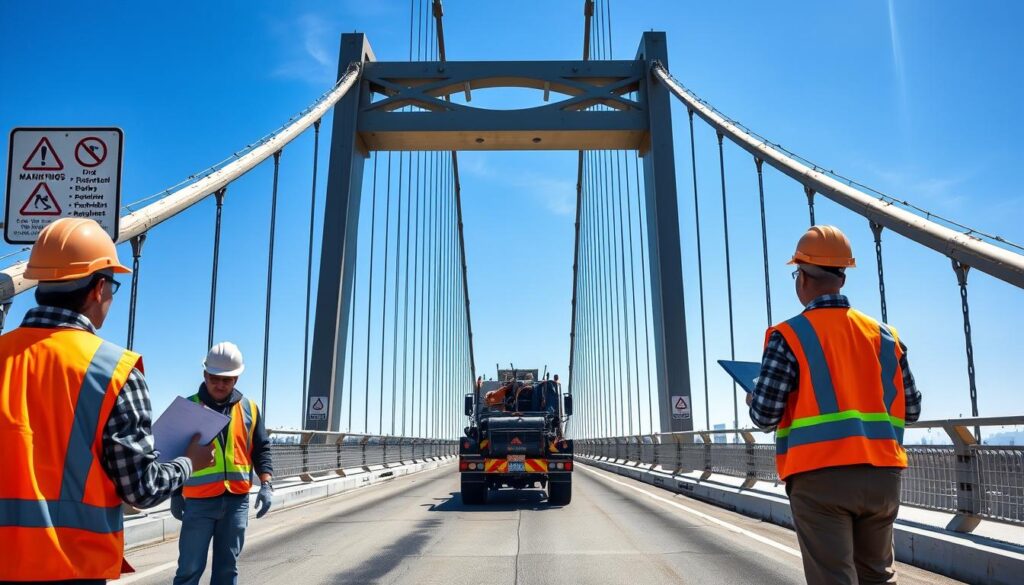
State-Specific Standards
In addition to federal regulations, each state has its own set of standards and guidelines for bridge maintenance. These state-specific standards may be more stringent than federal requirements and are designed to address local conditions and needs.
State departments of transportation are responsible for implementing and enforcing these standards, ensuring that bridges within their jurisdiction are maintained in accordance with both federal and state regulations.
Key aspects of state-specific standards include:
- Specific requirements for inspection frequencies and methodologies
- Guidelines for maintenance and repair activities
- Standards for materials and construction practices
By adhering to these regulatory standards and guidelines, bridge maintenance engineers can ensure that bridges are safe, durable, and compliant with relevant regulations. Effective bridge maintenance not only enhances public safety but also contributes to the overall efficiency of the transportation network.
The Role of Engineers in Bridge Maintenance
Engineers are at the forefront of bridge maintenance, utilizing their skills and knowledge to inspect and repair bridges. Their role is multifaceted, involving not just the technical aspects of maintenance but also collaboration with various stakeholders.
Skills and Qualifications Required
Engineers involved in bridge maintenance must possess a specific set of skills and qualifications. They typically require a degree in civil engineering or a related field, along with experience in structural analysis and repair techniques. Advanced knowledge of bridge inspection methods and bridge maintenance techniques is crucial for identifying potential issues before they become major problems.
The Chief, Division of Engineering, plays a pivotal role in developing bridge safety policy and guidelines. They may also review and approve bridge concepts and designs, ensuring that they meet the required safety standards.
Collaboration with Other Professionals
Effective bridge maintenance is not a solitary task; it requires collaboration with various professionals, including contractors, inspectors, and other engineers. This collaborative effort ensures that maintenance activities are carried out efficiently and safely.
Engineers work closely with inspectors to identify areas of concern and develop appropriate maintenance strategies. They also collaborate with contractors to implement repairs and ensure that work is done to the required standards.
| Professional | Role in Bridge Maintenance |
|---|---|
| Engineers | Design, inspect, and oversee repairs |
| Inspectors | Conduct routine inspections to identify issues |
| Contractors | Perform repairs and maintenance work |
By working together, these professionals can ensure that bridges remain safe and functional, minimizing disruptions to traffic and commerce.
Case Studies of Successful Bridge Maintenance
By examining case studies of successful bridge maintenance, we can identify best practices and areas for improvement. Recent projects have demonstrated the effectiveness of combining traditional techniques with innovative solutions.
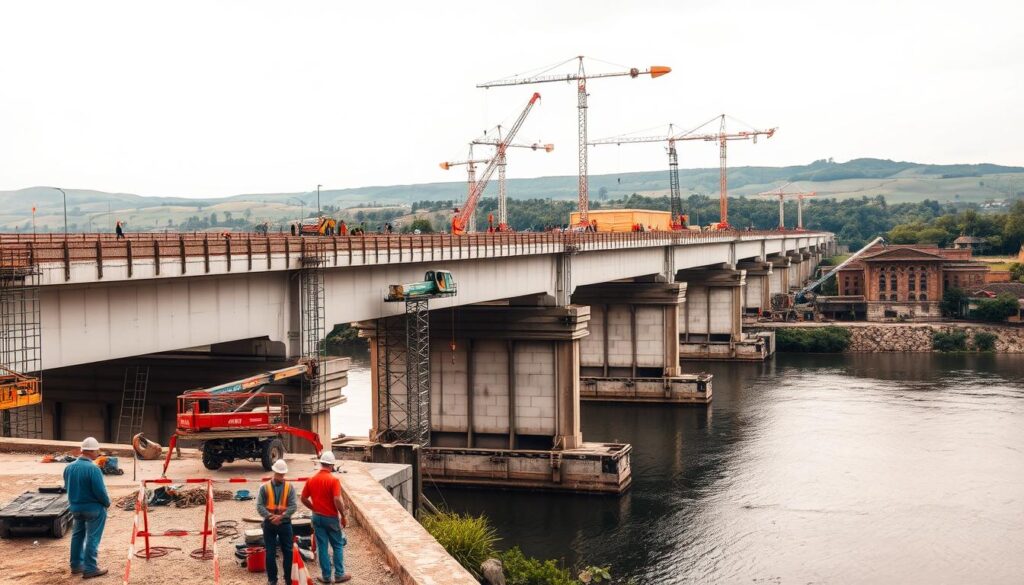
Lessons from Recent Projects
Several recent bridge maintenance projects have provided valuable insights into effective bridge rehabilitation strategies. For instance, the use of advanced inspection technologies has enabled engineers to identify potential issues before they become major problems.
- Regular inspections help in early detection of structural issues.
- Advanced materials and techniques improve the durability of repairs.
- Collaboration among stakeholders ensures that maintenance projects are completed on time and within budget.
Innovations That Improved Safety
Innovations in infrastructure maintenance solutions have significantly enhanced safety in bridge maintenance. For example, the adoption of UAV (Unmanned Aerial Vehicle) technologies, as seen in BNSF’s evaluation of UAV technologies for baseline data models of bridges, has improved the accuracy and efficiency of inspections.
Some key innovations include:
- The use of drones for inspecting hard-to-reach areas of bridges.
- Advanced software for maintenance management, enabling better planning and execution of maintenance tasks.
- New materials that offer improved durability and resistance to environmental factors.
These case studies highlight the importance of embracing new technologies and strategies in bridge maintenance to ensure the safety and longevity of our infrastructure.
The Impact of Weather on Bridge Maintenance
Understanding the impact of weather on bridges is essential for effective maintenance and ensuring structural integrity. Weather conditions can significantly affect the longevity and safety of bridges, making it crucial to incorporate weather-related factors into maintenance plans.
Effects of Temperature Fluctuations
Temperature fluctuations are among the most significant weather-related factors affecting bridge maintenance. Thermal expansion and contraction can lead to structural stress, potentially causing cracks and damage to the bridge’s components. For instance, during hot weather, the materials used in bridge construction expand, while in cold weather, they contract. This continuous cycle can lead to fatigue over time.
To mitigate the effects of temperature fluctuations, bridge maintenance engineers employ various strategies. One common approach is the use of expansion joints, which allow for the movement of bridge components without causing structural damage. Regular inspections are also critical to identify and address any issues related to temperature-induced stress.
Solutions for Weather-Related Deterioration
Weather-related deterioration can manifest in various forms, including corrosion, erosion, and damage from extreme weather events. To combat these issues, several bridge maintenance best practices can be adopted:
- Regular inspections to identify potential issues before they become major problems.
- Application of protective coatings to prevent corrosion.
- Use of durable materials that can withstand various weather conditions.
- Implementation of advanced drainage systems to prevent water accumulation.
Effective bridge inspection methods are crucial for detecting weather-related damage early. Techniques such as visual inspections, thermal imaging, and the use of drones equipped with high-resolution cameras can provide detailed insights into the condition of the bridge.
| Weather Factor | Impact on Bridge | Maintenance Solution |
|---|---|---|
| Temperature Fluctuations | Structural stress, cracks | Expansion joints, regular inspections |
| Rain and Flooding | Erosion, corrosion | Protective coatings, advanced drainage systems |
| Extreme Weather Events | Damage to structure and components | Regular inspections, use of durable materials |
By understanding the impact of weather on bridges and implementing appropriate maintenance strategies, engineers can ensure the longevity and safety of these critical infrastructure components.
Sustainability in Bridge Maintenance Engineering
Sustainable bridge maintenance engineering is not just a trend, but a necessity. As the world grapples with environmental challenges, the construction and maintenance of bridges are being reevaluated to reduce their ecological footprint.
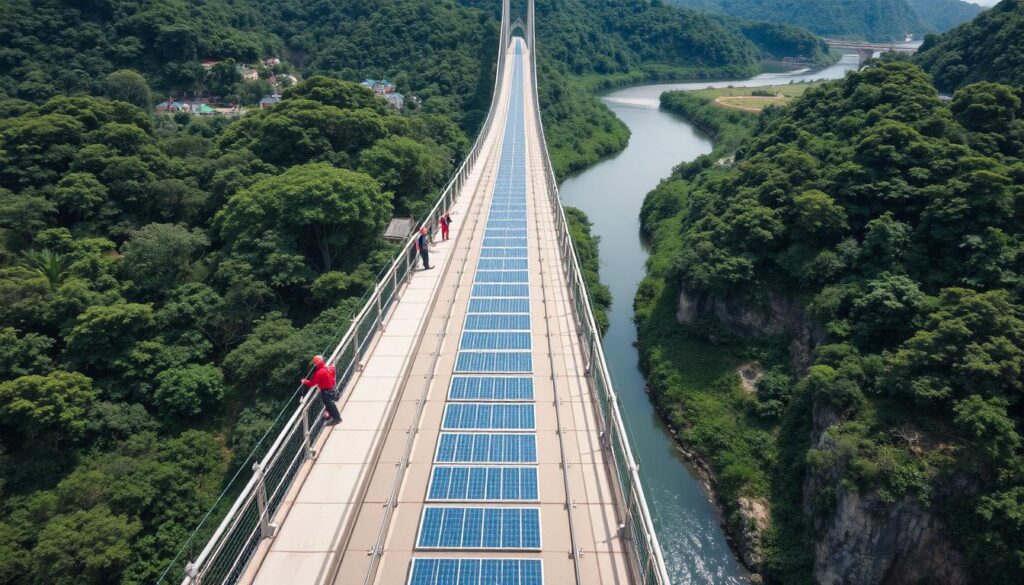
The use of eco-friendly materials and methods is becoming increasingly important in infrastructure maintenance solutions. This includes the adoption of recycled materials, sustainable coatings, and environmentally friendly construction practices that minimize waste and reduce the carbon footprint of bridge maintenance activities.
Eco-Friendly Materials and Methods
One of the key strategies in sustainable bridge maintenance is the use of eco-friendly materials. This involves selecting materials that are not only durable but also have a lower environmental impact. For instance, using recycled steel or sustainable timber can significantly reduce the environmental footprint of bridge repairs.
Moreover, innovative bridge rehabilitation strategies are being developed to minimize the disruption to traffic and local ecosystems. Techniques such as modular construction and prefabricated components are being increasingly adopted to achieve this goal.
Reducing Environmental Impact
Reducing the environmental impact of bridge maintenance also involves adopting practices that minimize waste and pollution. This includes implementing effective waste management plans and using cleaner technologies for maintenance activities.
The Regional Engineer plays a crucial role in this process by reviewing, approving, and signing off on the final design documents before the procurement of construction materials or services for bridge rehabilitation or replacement projects. This ensures that all projects meet the required sustainability standards.
By embracing sustainability in bridge maintenance engineering, we can ensure that our infrastructure is not only safe and durable but also environmentally friendly. This approach is essential for creating a more sustainable future for our communities.
Future Trends in Bridge Maintenance Engineering
The bridge maintenance landscape is evolving with the integration of advanced technologies. As infrastructure ages, the need for efficient, effective, and innovative maintenance strategies becomes increasingly critical.
The Rise of Smart Bridge Technology
Smart bridge technology is revolutionizing the field of bridge maintenance by incorporating real-time monitoring systems and advanced sensors. These technologies enable engineers to assess the condition of bridges more accurately and respond to potential issues before they become major problems. For instance, innovations in bridge engineering are paving the way for more resilient and sustainable bridge infrastructure.
The use of bridge management systems is becoming more prevalent, allowing for the systematic management of maintenance activities. These systems help in tracking the condition of bridges, scheduling inspections, and planning repairs. By leveraging data analytics and IoT technologies, bridge management systems can significantly enhance the efficiency of maintenance operations.
Predictive Maintenance Practices
Predictive maintenance is another trend gaining traction in bridge maintenance engineering. By utilizing data from various sources, including sensors and inspection reports, predictive models can forecast when maintenance should be performed. This proactive approach helps in preventing unexpected failures and reducing downtime.
BNSF is testing tools that enable them to refine the detection of changes on their bridge structures using UAV technologies. This adoption of predictive maintenance techniques is a prime example of how the industry is moving towards more proactive and data-driven maintenance strategies.
The integration of these future trends in bridge maintenance engineering is set to improve safety, reduce costs, and enhance the overall efficiency of maintenance activities. As the industry continues to evolve, we can expect to see even more innovative solutions emerge, further transforming the landscape of bridge maintenance.
Community Involvement in Bridge Maintenance
Involving the community in bridge inspection methods and infrastructure maintenance solutions can lead to more effective maintenance outcomes. By engaging local stakeholders and raising public awareness, bridge maintenance projects can benefit from a collaborative approach.
Public Awareness and Education
Public awareness and education are crucial for the success of bridge maintenance projects. Educating the public about the importance of bridge maintenance can lead to increased support and participation in maintenance activities. For instance, community outreach programs can inform the public about the role they can play in reporting potential issues or participating in inspection activities.
Key Strategies for Public Awareness:
- Organizing community events to educate the public about bridge maintenance
- Utilizing media channels to disseminate information about ongoing maintenance projects
- Collaborating with local schools to incorporate bridge maintenance into educational curricula
Engaging Local Stakeholders
Engaging local stakeholders is vital for the long-term success of bridge maintenance projects. This includes working with local businesses, community groups, and government agencies to ensure that maintenance activities are aligned with community needs and priorities.
Effective Stakeholder Engagement:
| Stakeholder Group | Engagement Strategies | Benefits |
|---|---|---|
| Local Businesses | Regular meetings, economic impact assessments | Minimized disruptions, economic benefits |
| Community Groups | Public forums, volunteer opportunities | Increased community support, enhanced project visibility |
| Government Agencies | Regulatory compliance, funding partnerships | Ensured compliance, access to additional funding |
Project Leaders and Facility Managers should review all repair and maintenance recommendations in the latest bridge inspection report and complete “Urgent” repairs immediately upon availability of funds and materials. This proactive approach ensures that critical maintenance needs are addressed promptly, enhancing the safety and durability of the bridge.
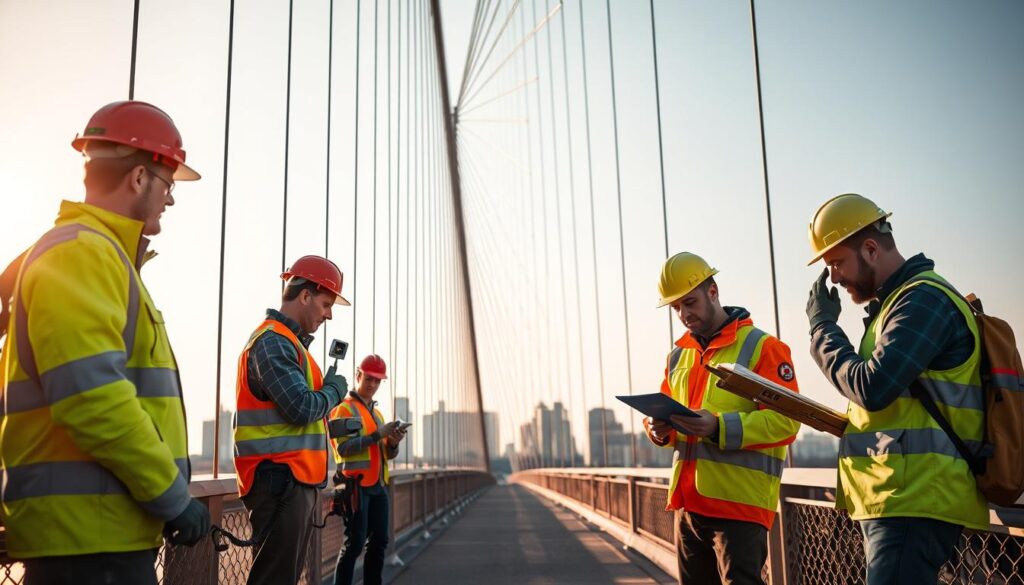
The Economic Impact of Proper Bridge Maintenance
Proper bridge maintenance has a significant economic impact that affects not just the local infrastructure but also the broader economy. By investing in bridge rehabilitation strategies, communities can ensure the longevity of their bridges, thereby supporting local businesses and fostering economic growth.
Maintaining existing bridge widths is a crucial aspect of bridge maintenance, unless safety concerns necessitate restricting a section of the bridge from traffic. This approach not only ensures the safety of the bridge users but also prevents unnecessary expenditures on widening or reconstructing bridges that are still structurally sound.
Cost-Benefit Analysis of Maintenance Projects
Conducting a thorough cost-benefit analysis is essential for understanding the economic implications of bridge maintenance projects. This involves evaluating the costs associated with maintenance activities against the benefits derived from these activities, such as extended bridge lifespan and improved safety.
Effective bridge maintenance best practices can lead to significant cost savings over time. For instance, regular inspections and preventive maintenance can identify potential issues before they become major problems, thereby reducing the need for costly repairs or replacements.
- Reduced repair costs through early detection of issues
- Extended lifespan of bridges
- Improved safety for users
- Economic benefits through sustained infrastructure
Effects on Local Infrastructure
The impact of bridge maintenance on local infrastructure is multifaceted. Well-maintained bridges support the smooth operation of transportation networks, facilitating the movement of goods and people. This, in turn, can boost local economic activity by improving access to markets, employment, and services.
Moreover, investing in bridge maintenance can have positive ripple effects on surrounding infrastructure. For example, maintaining bridges can reduce traffic congestion on alternative routes, thereby decreasing wear and tear on those roads and improving overall network efficiency.
By adopting a proactive approach to bridge maintenance, communities can reap significant economic benefits while ensuring the safety and reliability of their transportation infrastructure.
Conclusion
Bridge maintenance engineering plays a crucial role in ensuring the safety and longevity of bridges. As discussed, various techniques and technologies are employed to maintain bridge integrity, including the use of high-performance concrete, fiber-reinforced polymer materials, and advanced inspection technologies.
Bridging the Gap with Infrastructure Maintenance Solutions
The Innovative Bridge Research and Construction (IBRC) has significantly contributed to the development of infrastructure maintenance solutions, promoting the use of advanced materials and techniques. The Assistant Director – Business Management and Operations plays a vital role as a senior advisor for activities related to engineering, underscoring the importance of effective bridge maintenance engineering.
Ongoing Maintenance for a Safer Future
To ensure the continued safety and functionality of bridges, ongoing maintenance is essential. By adopting infrastructure maintenance solutions and staying abreast of the latest technologies and techniques, we can extend the lifespan of bridges and prevent costly repairs. Effective bridge maintenance engineering is key to achieving this goal.
